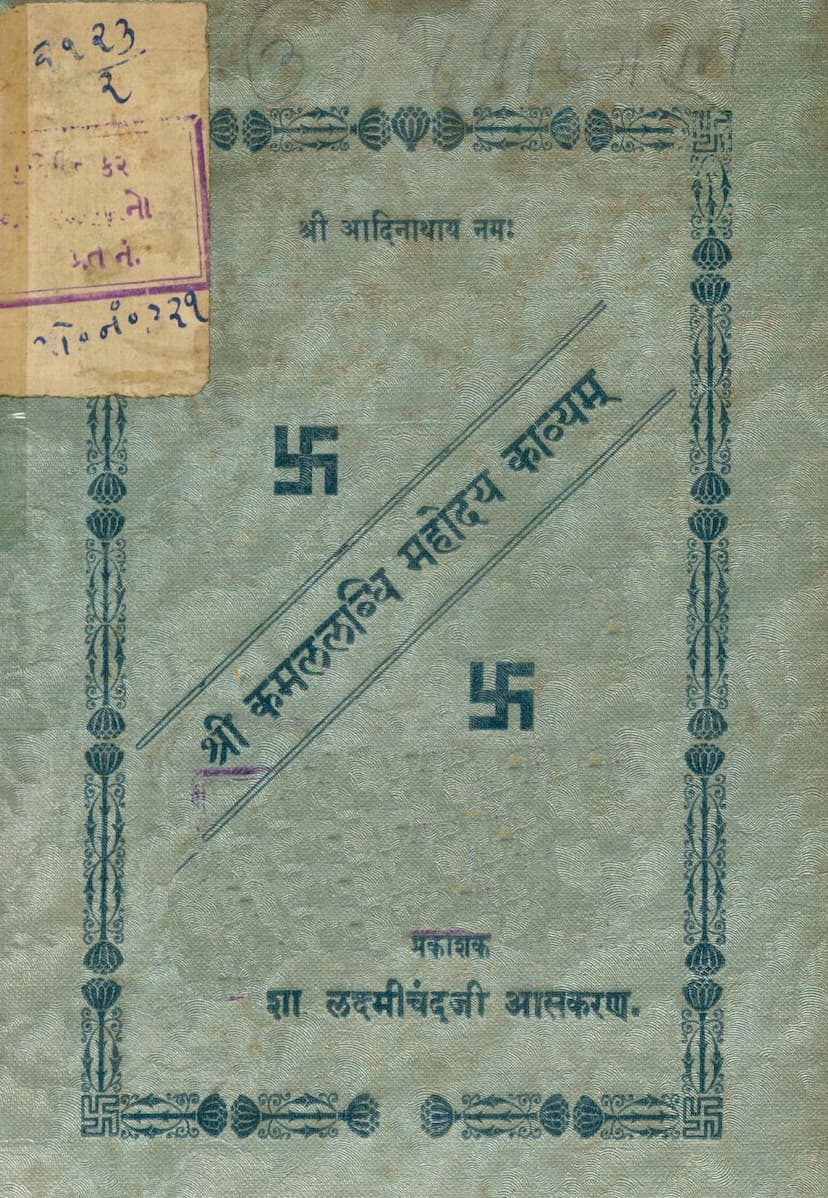Kamal Labdhi Mahoday Kavyam
Added to library: September 2, 2025

Summary
Here's a comprehensive summary of the Jain text "Kamal Labdhi Mahoday Kavyam," based on the provided pages:
Book Title: Kamal Labdhi Mahoday Kavyam (श्री कमललब्धि महोदय काव्यम्) Author: Vrajnath Narayan Acharya (प० नारायण आचार्येण, न्यायाचार्येण) Publisher: Lakshmichand Kochar (शा. लक्ष्मीचंदजी आसकरण, कोचर लक्ष्मीचंदः)
Overall Purpose: This Jain text is a poetic biography (kavya) chronicling the life and teachings of Acharya Shrimad Vijaykamalsurishwarji Maharaj. It aims to inspire readers by highlighting his virtues and the impact of his spiritual guidance. The author, Vrajnath Narayan Acharya, presents this work as a means for readers to gain spiritual merit and personal development.
Key Figures:
- Acharya Shrimad Vijaykamalsurishwarji Maharaj: The central figure of the biography, celebrated for his profound knowledge, devotion to Jain principles, compassion, and persuasive teachings.
- Acharya Shrimad Vijayanand Surishwarji Maharaj (Atmaramji): The guru of Vijaykamalsurishwarji, recognized as a significant spiritual lineage.
- Acharya Shrimad Vijayladdhisurishwarji Maharaj: A successor to Vijaykamalsurishwarji, also depicted as a prominent Acharya.
- Vrajnath Narayan Acharya: The author, a learned scholar and poet dedicated to Jainism.
Content Summary:
-
Invocation and Dedication: The text begins with invocations to Lord Adinath and Acharya Vijayanand Surishwarji. It is published by Lakshmichand Kochar, with the first edition in V.S. 2461 (1984 CE). The author expresses his intention to write the biography in a poetic style, adorned with various meters and figures of speech.
-
Author's Intent (Prastavana):
- The author emphasizes the importance of studying the lives of great souls for personal growth and spiritual advancement.
- He notes the difficulty in fully documenting the lives of such prominent figures due to the passage of time but considers it essential to record what is known for future generations.
- The text's primary focus is on the birth, renunciation, detachment, diligence, fearlessness, dedication to duty, devotion to the Three Jewels (Ratnatraya), and extensive preaching of Acharya Vijaykamalsurishwarji to various kings and people.
- The author hopes that readers will benefit from reading the "Kamal Labdhi Mahoday Kavyam" by imbibing the virtues of the Acharya.
-
Biographical Narrative: The majority of the text comprises poetic verses detailing the life events of Acharya Vijaykamalsurishwarji. While the full chronological order is extensive, key themes and events include:
- Birth and Early Life: Descriptions of his birth in a respected place (Sarasetipura), his family, and his early inclinations.
- Renunciation and Monastic Life: His decision to renounce worldly life, receive initiation (diksha), and his rigorous adherence to monastic vows. His youth is highlighted as a period of intense spiritual practice and learning.
- Learning and Scholarship: His mastery of various scriptures, logic, grammar, and other arts, becoming a scholar of repute.
- Preaching and Teachings: His profound discourses on Jain philosophy, emphasizing virtues like non-violence (ahimsa), detachment, truthfulness, and right conduct.
- Travels and Mission: His extensive travels across various regions (Panchala, Gujarat, Saurashtra, Malwa, etc.) to spread Jain Dharma, visit pilgrimage sites, and guide disciples.
- Conversions and Impact: His ability to influence people from all walks of life, including kings, scholars, and ordinary citizens, towards righteous living. He is depicted as a beacon of knowledge and virtue.
- Debates and Victories: His prowess in philosophical debates, where he would defeat opponents with his superior knowledge and logic.
- Miracles and Powers (Labdhi): The title "Kamal Labdhi" suggests the presence of miraculous powers attained through his spiritual practices.
- Disciple Succession: The grooming and initiation of disciples, including prominent figures like Laddhichandra, Kamal Vijay, and others who carried forward his legacy.
- Confrontation with Wrong Views: His active role in correcting erroneous beliefs and practices, upholding the true Jain tradition.
- Later Life and Nirvana: The text eventually leads to his passing and the reverence with which his final moments and passing are remembered.
- Establishment of Institutions: Mention of his influence in establishing or supporting religious centers and activities.
-
Key Virtues Highlighted:
- Wisdom and Erudition: Deep knowledge of Jain scriptures and allied sciences.
- Renunciation and Detachment: Freedom from worldly attachments and desires.
- Compassion and Non-violence: Profound empathy for all living beings.
- Diligence and Perseverance: Unwavering dedication to spiritual practice and duty.
- Eloquent Preaching: The ability to convey profound truths in an understandable and persuasive manner.
- Ethical Conduct: Strict adherence to monastic discipline and ethical principles.
-
Structure and Style:
- The text is written in Sanskrit, employing various poetic meters (chandas) and literary devices (alankars).
- It follows a narrative structure, presenting the life events in a poetic and often devotional manner.
- A Shuddhipatraka (Corrigenda) is included, indicating corrections made to the text.
- The text also includes Prashasti Padyani (verses of praise) for Acharya Vijayladdhisurishwarji, suggesting a connection or lineage.
In essence, "Kamal Labdhi Mahoday Kavyam" is a devotional and biographical epic celebrating the spiritual journey and exemplary life of Acharya Shrimad Vijaykamalsurishwarji Maharaj, offering readers a detailed poetic account of his contributions to Jainism.